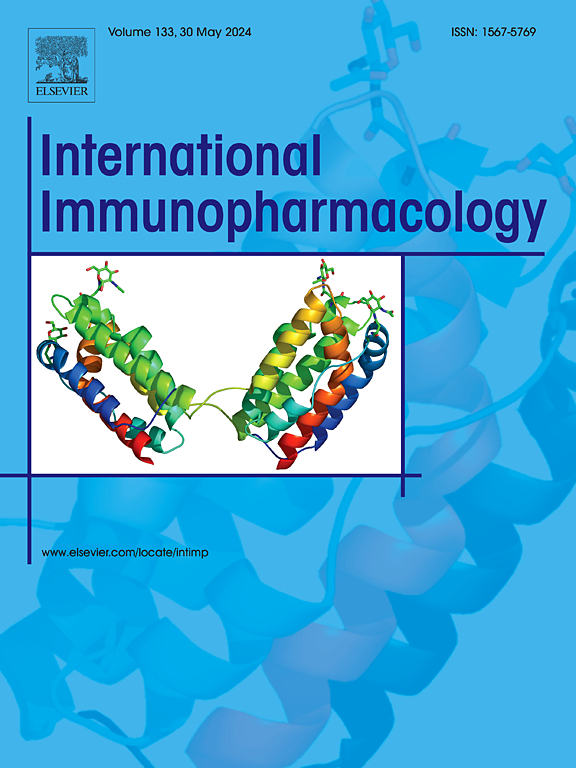Vitamin D against diabetic adipose tissue inflammation through SHP-1/STAT3 pathway
IF 4.8
2区 医学
Q2 IMMUNOLOGY
引用次数: 0
Abstract
Purpose
This study aimed to investigate the anti-inflammatory effects of vitamin D (VD) on adipose tissue in type 2 diabetes mellitus (T2DM), with a particular focus on its regulation of macrophage polarization and the SHP-1/STAT3 signaling pathway.
Methods
A T2DM rat model was induced in 4-week-old Sprague-Dawley rats by feeding a high-fat diet followed by a low-dose streptozotocin injection. After successful model induction, the diabetic rats were treated with varying doses of vitamin D3 (VD3) for 10 weeks to evaluate its effects on adipose tissue inflammation associated with T2DM. To further elucidate the underlying mechanisms, high-glucose (HG)-stimulated RAW264.7 macrophages were employed as an in vitro model to investigate the anti-inflammatory effects of 1,25(OH)2D3, with particular emphasis on the SHP-1/STAT3 signaling pathway.
Results
VD3 treatment significantly improved body weight, reduced water intake and urine output, and alleviated hyperglycemia and dyslipidemia in T2DM rats (P < 0.05). Histological analysis revealed restored adipocyte morphology and reduced expression of inflammatory cytokines (TNF-α, IL-6, TGF-β1, MCP-1; P < 0.05). Immunofluorescence and protein analyses demonstrated that VD3 inhibited M1 macrophage polarization and enhanced the M2 phenotype. Moreover, VD3 upregulated SHP-1 expression while downregulating p-STAT3 in adipose tissue (P < 0.05). In vitro, 1,25(OH)2D3 restored cell viability, suppressed pro-inflammatory cytokine production, and promoted M2 polarization under HG conditions (P < 0.05). Inhibition of SHP-1 using TPI-1 abrogated these effects, whereas STAT3 inhibition with stattic further enhanced the anti-inflammatory responses (P < 0.05).
Conclusion
VD mitigates adipose tissue inflammation and metabolic dysfunction in T2DM by regulating macrophage polarization via the SHP-1/STAT3 signaling pathway.
维生素D通过SHP-1/STAT3途径抗糖尿病脂肪组织炎症
目的研究维生素D (VD)对2型糖尿病(T2DM)脂肪组织的抗炎作用,重点研究其对巨噬细胞极化和SHP-1/STAT3信号通路的调节作用。方法采用高脂饲粮加低剂量链脲佐菌素诱导4周龄Sprague-Dawley大鼠T2DM模型。模型诱导成功后,用不同剂量的维生素D3 (VD3)治疗糖尿病大鼠10周,以评估其对T2DM相关脂肪组织炎症的影响。为了进一步阐明其潜在机制,我们采用高糖(HG)刺激RAW264.7巨噬细胞作为体外模型,研究1,25(OH)2D3的抗炎作用,特别强调了SHP-1/STAT3信号通路。结果vd3治疗可显著改善T2DM大鼠体重,减少饮水量和尿量,减轻高血糖和血脂异常(P <;0.05)。组织学分析显示脂肪细胞形态恢复,炎症因子(TNF-α、IL-6、TGF-β1、MCP-1;P & lt;0.05)。免疫荧光和蛋白分析表明,VD3抑制M1巨噬细胞极化,增强M2表型。此外,VD3上调脂肪组织中SHP-1的表达,下调P- stat3的表达(P <;0.05)。在体外,1,25(OH)2D3在HG条件下恢复细胞活力,抑制促炎细胞因子的产生,促进M2极化(P <;0.05)。用TPI-1抑制SHP-1可消除这些作用,而用STAT3抑制STAT3可进一步增强抗炎反应(P <;0.05)。结论vd通过SHP-1/STAT3信号通路调节巨噬细胞极化,减轻T2DM患者脂肪组织炎症和代谢功能障碍。
本文章由计算机程序翻译,如有差异,请以英文原文为准。
求助全文
约1分钟内获得全文
求助全文
来源期刊
CiteScore
8.40
自引率
3.60%
发文量
935
审稿时长
53 days
期刊介绍:
International Immunopharmacology is the primary vehicle for the publication of original research papers pertinent to the overlapping areas of immunology, pharmacology, cytokine biology, immunotherapy, immunopathology and immunotoxicology. Review articles that encompass these subjects are also welcome.
The subject material appropriate for submission includes:
• Clinical studies employing immunotherapy of any type including the use of: bacterial and chemical agents; thymic hormones, interferon, lymphokines, etc., in transplantation and diseases such as cancer, immunodeficiency, chronic infection and allergic, inflammatory or autoimmune disorders.
• Studies on the mechanisms of action of these agents for specific parameters of immune competence as well as the overall clinical state.
• Pre-clinical animal studies and in vitro studies on mechanisms of action with immunopotentiators, immunomodulators, immunoadjuvants and other pharmacological agents active on cells participating in immune or allergic responses.
• Pharmacological compounds, microbial products and toxicological agents that affect the lymphoid system, and their mechanisms of action.
• Agents that activate genes or modify transcription and translation within the immune response.
• Substances activated, generated, or released through immunologic or related pathways that are pharmacologically active.
• Production, function and regulation of cytokines and their receptors.
• Classical pharmacological studies on the effects of chemokines and bioactive factors released during immunological reactions.

 求助内容:
求助内容: 应助结果提醒方式:
应助结果提醒方式:


